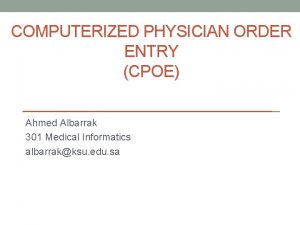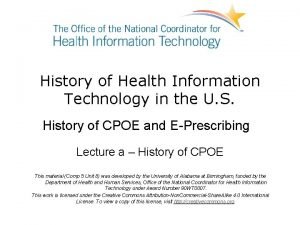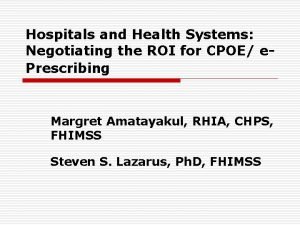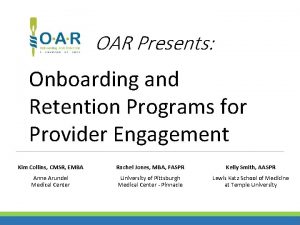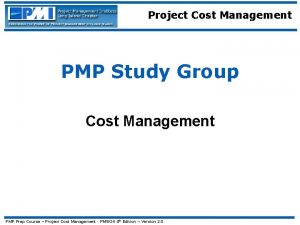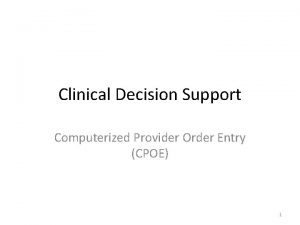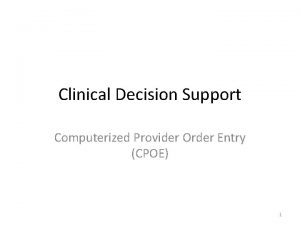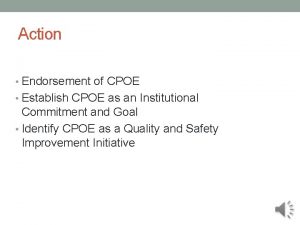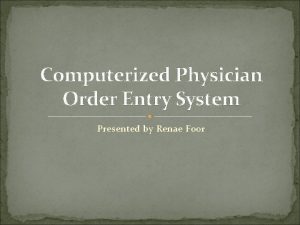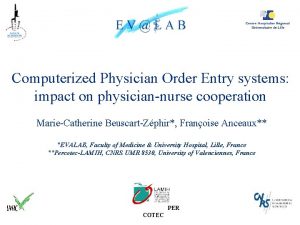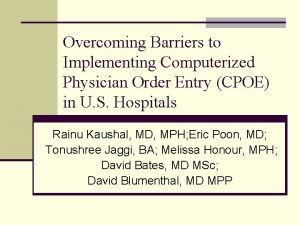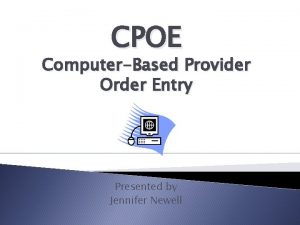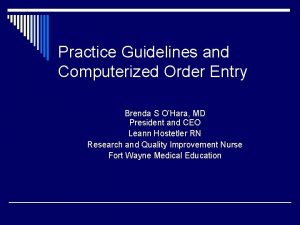Computerized Physician Order Entry CPOE Process Costs and


















- Slides: 18

Computerized Physician Order Entry (CPOE), Process, Costs and Benefits Joe Shaffer, MS Alberto Coustasse, Dr. PH, MD Graduate School of Management, College of Business Marshall University

INTRODUCTION • Computerized Provider Order Entry (CPOE) • Medication orders (as well as tests and procedures) are entered into a computer system by a physician or qualified provider. • Medication orders are transmitted directly to the pharmacy. • At a minimum, ensures standardized, legible, and complete orders. • Has the potential to greatly reduce errors at the ordering and transcribing stages.

Adverse Drugs Events (ADEs) & Medication Errors • Several studies have found serious medication errors in 3. 4%-5. 3% of inpatients (8 th cause of death, more than HIV+ breast cancer together). • 1. 5 million medication errors per year. • The cost of a single preventable ADE has been estimated to be $4, 685. • $1. 3 million ADE annually for an average 300 bed

INTRODUCTION • Health Information Technology for Economic and Clinical Health (HITECH) Act of 2009. • Meaningful Use: • The use of certified EHR technology for electronic exchange of health information (HIE) to improve quality of healthcare and includes the use of CPOE.

PURPOSE • To assess the CPOE to identify areas of benefit and concern.

BENEFITS THROUGH EFFICIENCY • Placement of orders to nurse receipt before implementation was 41. 2 minutes (38. 4 minutes for clerical, 2. 1 minutes for finding the chart and. 72 minutes for writing the order). • After CPOE implementation the order placement was 27 seconds.

MD Unit Sec. Nurse Pharmacy Locate Chart If available Write Order Flag Chart Return Chart to Rack Periodically Review Chart Rack Check Order Completeness Enters Order in Computer Notifies Rx Notify Nurse Check Order Completeness Notifies Rx Rx Enters the Order Rx Verifies Order Med Sent to Floor

BENEFITS THROUGH EFFICIENCY • Similarly, the pharmacy had a 64% decrease with 2. 24 minutes savings from order entry to pharmacy and 1. 36 minutes from pharmacy to medication administration. • Clinical Laboratory pathology decreased 25%, from 31: 30 to 23: 40 minutes.

COST SAVINGS THROUGH EFFICIENCY • Nurses workload decreased (4%-6%) due to process medication orders. This was a savings of 20 minutes per nurse per day which was calculated to $715, 000 per year. • Pharmacists saved 60% of their workload, 200 minutes per pharmacist per day, which was $2, 044, 000 per year.

ALERT FATIGUE • The most recognized overriding “complication” has been alert fatigue, either the alert was not serious, irrelevant or shown repeatedly. • Physicians have been found to lack understanding of workflow interruptions and importance of warnings, and often perceived written orders as superior.

MEDICATION ERRORS • Reports have ranged for a 55% to 66% decrease in medication errors in adults. • The greatest benefit was demonstrated in one RCT with a decrease of 175 medication errors per 1, 000 orders. • Also was estimated a prevention of 3 million Adverse Drug Events each year (9 per 1, 000 prescriptions in pediatrics and 12 per 1, 000 prescriptions in adults).

OVERALL COST • In 2003, the overall cost of implementation for the average hospital was $3. 2 million. • This cost also depends on the hospital bed size: ü than 200 bed is about $1. 4 million. ü 500 bed plus: $12. 5 million. • Expenses included professional services (31%), core system (25%), hardware (21%), software (14%) and additional functions (9%).

EVOLUTION • Only 10%-15 % of medical facilities have CPOE completely available. • Physician Acceptance and Behavioral Changes • Training sessions, multidisciplinary teams, and consultation support.

UNINTENDED ADVERSE CONSEQUENCES (UACS) • One study was conducted to indentify the different types of UACs resulting from CPOE implementation • 79 unintended consequences were identified • 245 additional ones were added from fieldwork • There are nine major categories in order of decreasing frequency: • More/new work for clinicians • Workflow • Never-ending system demands • Persistence • Changes in communication patterns • Emotions • New kinds of errors • Changes in power structure • Overdependence on technology

DISCUSSION • Millions of dollars have been invested in HIT, but still is in infant stage • Hospitals need NOT to develop their own software rather joint national standards. • Balance on Alerts (otherwise physicians will ignore them).

DISCUSSION • There is no measurable ROI for a healthcare setting, however: • The virtual ROI’s are: • CPOE will probably be mandatory • If the health care system doesn’t have it, there will be financial penalties (meaningful use, 2015) • Improved patient safety will result in: üReduction in Medical Errors. üShorter Lengths of Stay. üFewer Law Suits. üBetter Quality of Care (Better PS & Reputations).

DISCUSSION • Most studies have been conducted in large academic centers so further research is required in rural settings.

Questions? coustassehen@marshall. edu
 Computerized physician order entry definition
Computerized physician order entry definition Cpoe
Cpoe History of cpoe
History of cpoe Cpoe vs e prescribing
Cpoe vs e prescribing Return process in sap sd
Return process in sap sd Conversion method in single entry system
Conversion method in single entry system Difference between single and double entry system
Difference between single and double entry system 1st order 2nd order 3rd order neurons
1st order 2nd order 3rd order neurons New entry exploitation
New entry exploitation Benefits of job order costing
Benefits of job order costing Both job order costing and process costing
Both job order costing and process costing Hcp segment
Hcp segment Onboarding portal upmc
Onboarding portal upmc Potential rating scale appraisal problems
Potential rating scale appraisal problems Difference between manual and computerized accounting
Difference between manual and computerized accounting Types of appraisal interview
Types of appraisal interview Auditing through the computer
Auditing through the computer Computerized and web-based performance appraisal
Computerized and web-based performance appraisal What is bac project management
What is bac project management
